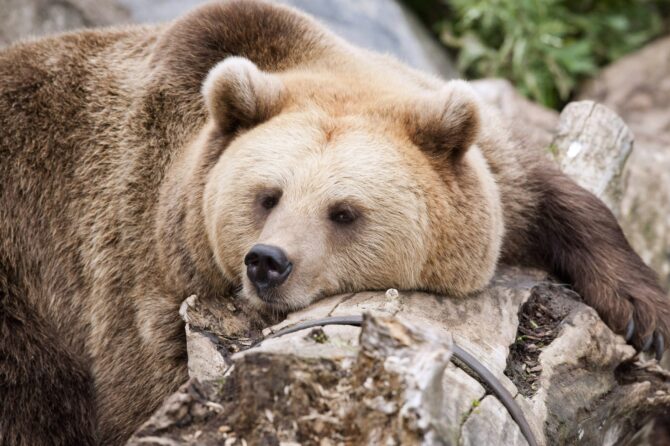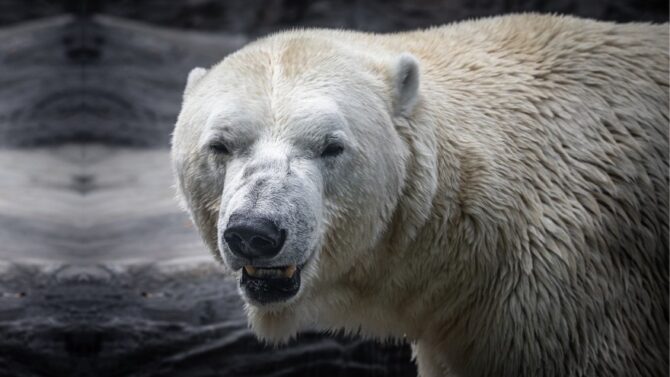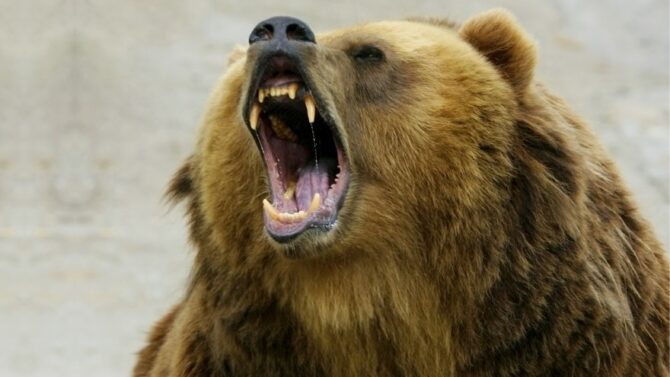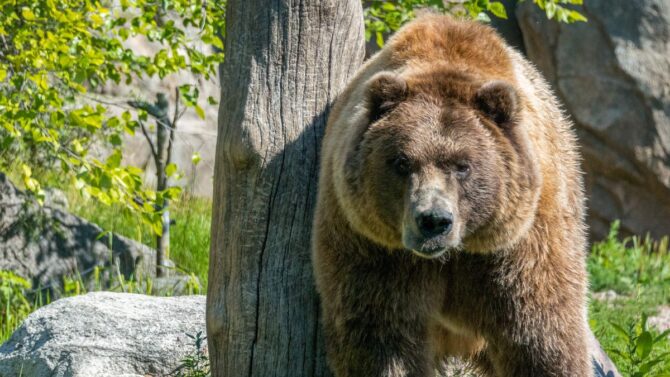Bears are mammals classified in the Ursidae family and are termed “dog-like carnivorans.”
They are widespread and can be found in different habitats, giving the impression that a lot of species are still alive today. However, that’s not the case. Only eight species are extant today.
Their wide range makes them popular, but they tend to be feared, especially by campers.
While not considered deadly towards humans, attacks are likely if the bear feels threatened. This will more likely happen if there is a cub nearby.
It isn’t all doom with these animals, though. Let’s delve into all we need to know.
Scientific Classification

| Kingdom | Animalia |
| Phylum | Chordata |
| Class | Mammalia |
| Order | Carnivora |
| Family | Ursidae |
| Genus | Ursus |
| Scientific Name | Ursidae |
Characteristics
| Height | 4 to 11 ft |
| Weight | 60 to 90 pounds |
| Venom/Poison | No |
| Skin Type | Fur |
| Habitat | Grasslands, rainforests |
| Range | Asia, North America, Europe |
| Diet | Omnivore |
| Life span | 15 to 35 years |
| Gestation Period | 95 to 270 days |
| Conservation status | Endangered |
Interesting Facts About Bears
1. Whatever you do, don’t think you can outrun a bear
Unlike in the movies, running away from chasing Ursus is a bad idea.
They move at a faster pace than humans despite their size, and some have been known to go as fast as 30 to 35 miles per hour.
Humans fall dismally low as our average speed is between 6.5 to 8 mph.
There are better ways to survive an attack, and it often depends on the species in question.
The black bear can be scared off. You may need to play dead if you encounter a grizzly.
The best method is to not let them see you in the first place. Here’s more information from the National Park Service on this matter.
2. Brown bears are the most widespread species
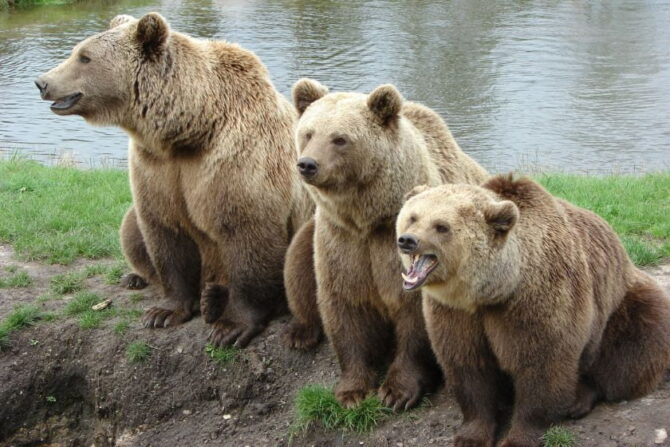
The brownies used to have a wider range, covering more ground than they do now.
However, local extinction in some regions has narrowed the range. They are still the most widespread of all bear species.
You can currently find the brown bear in Europe, Asia, and North America, with the larger population located in countries like the United States, Canada, and Russia.
3. Black bears are not always black

The name given to this species can be a misnomer in some cases. While many black bears are indeed the color, there are varieties amongst them.
Some individuals are black, brown, cinnamon, gray, and even white. The environment a black bear finds itself in influences its color.
One that lives in the West of the United States will have a lighter color, and the blackies in this area are usually brown. Their northeast counterparts come in a darker color.
4. Panda babies are very small
The adult panda looks big and sometimes intimidating, but it doesn’t start life that way.
As a baby, this species is very small. It weighs 3.5 ounces, the equivalent of a small apple.
These babies are one of the smallest mammals when compared to their mother’s size.
This is why you should never mess with a panda mom. The tiny baby is very vulnerable, which makes the mother protective. Do not get too close to a panda cub.
5. Only one species lives in the southern hemisphere
Most species are located in the Northern hemisphere, but there’s one that finds itself in a different place.
The spectacled bear lives in the southern hemisphere, and it is also called the Andean bear because there are a lot of them in the Andes mountains of South America.
Its range goes from western Venezuela to western Bolivia and other places like Argentina.
The markings on the spectacled bear’s face earned it the name.
They are cream-colored and surround the eyes, making this animal look bespectacled. It is the only one of its kind found in the southern hemisphere.
General Description
Let’s begin with short descriptions of the 8 extant species:
- North America Black bear: Can be located in North America, going from Northern Canada to Central Mexico. Its habitat varies, as it can live in mountainous regions or on meadows and wetlands.
- Brown bear: Also known as the grizzly, it is located in North America, Europe, and Asia. These are big creatures and easily recognizable.
- Sun bear: Has a marking on the chest that’s colored cream, which earned it the name. It is also called the honey bear because it eats bees’ nests. This species is on the brink of extinction, but you can still find it in Malaysia and Indonesia.
- Polar bear: Polars inhabit the Arctic region, and that’s the only place they can be found. The melting of ice endangers this species.
- Spectacled bear: The only species found in America, you will find them hanging on trees. Human hunting has put them at risk of extinction.
- Moon bear: Also known as the Asiatic brown bear, this is a herbivorous species that can be found in Asia. They inhabit mountains and are arboreal.
- Panda bear: Often associated with China, this species is admired by many for its unique appearance.
- Sloth bear: This species is similar to the sloth, hence the name. Its diet is unique as it can feed on insects thanks to its snout.
Generally, these mammals are recognized by their fur skin, sharp claws, and large head with two-minute ears.
Species and subspecies have markings that distinguish them, but you can easily know a bear when you see one.

The distinctive traits of the species can help them adapt to their environments. That’s why polars have white fur and the North American black bear enjoys a variety of meals.
Behavior
Bears are solitary animals, only coming together when they need to mate and reproduce.
Besides mating season, they hunt and live on their own. Mothers do travel with cubs when the latter is still dependent, but other than those exceptions, bears are not social.
Amongst mammals, these animals have a keen sense of sight, hearing, and smell. Their senses are better than humans, and their smell is said to be better than a bloodhound.
They rely on their sense of smell even more than their sight. It is with the smell that they can detect humans.
They are usually wary of humans and may flee, but that’s not always the case.
Hibernation is a key trait of these animals during the winter season because there won’t be much food supply during that period.
Bears hibernate in different locations such as caves, underground holes, dens, holes in trees, etc.
Because of the food shortage during hibernation, they eat excessively before winter. This is known as hyperphagia.
Distribution and Habitat
The only continents these animals never got to are Antarctica and Australia. They can no longer be found in Africa, thanks to extinction.
We’re left with the species that are in North America, South America, Europe, and Asia.
They can be found in 60 countries and only one is located in the Southern Hemisphere. The rest are Northern.
Their habitats are multiple as these animals can adapt to any environment.
These include rainforests, forests, steppes, grasslands, and drifting ice for polar bears. Dens are their homes, but they could also find shelter somewhere else.
Diet
Bears are survivors, and they have proven to get sufficient food in any environment.
Though they are classified under the Carnivora order and seem like carnivores, these folks are omnivores.
They may prioritize plants or animals depending on the species in question. That said, most feed on vegetation.
There are three species known to feed a lot of meat. The polar bear is primarily carnivorous, feeding on whales, seals, and walruses.
The North American species feeds on animals too, and the sloth bear has an insectivorous diet.
One thing to note is this: Never feed a wild bear! It may seem like a kind and humane thing to do, but the repercussions are high.
Not only does it erode them of their wild instincts, but they would also get an insatiable appetite for human food. This could lead to attacks and break-ins.
Reproduction and Mating Process
Mating occurs during the spring, set between May and early July.
While there’s a courtship process that happens between a male and a female, monogamy isn’t guaranteed.
Males can mate with several females as it is natural for them to be promiscuous.
Females aren’t exempt, too, as they can have many male partners. Mating is usually competition, and the largest males have the advantage.
Bears are considered some of the least productive mammals in North America, and in the space of 10 years, a male and female might only get 10 to 15 offspring.
The couple that courts and mates usually forms a bond during that period.
The female fertilizes eggs just like humans do and gives birth live. She usually gives birth in January and February to a maximum of 6 cubs.
Like many mammals, the cubs are vulnerable and dependent on their mothers. The latter is more protective in that period.
Mothers feed and take care of the cubs till the separation period. This is usually hard on the cubs, and they often stay with their siblings for a period to adapt.
Predators and Threats
As big animals, adults have few predators. They can hold their own against any other animal and are usually only preyed upon by other bears and humans.
These animals are territorial and may compete with themselves, leading to injuries. They also get hunted down by humans, especially the illegal kind.
Bear hunting is legal in many US states, but hunters need to have a permit.
Those that don’t have are the biggest threats to these animals as they hunt without restraint for meat and sell organs.
Frightened campers or hikers can also harm a bear in defense.
Cubs can be preyed upon by some wild animals, so they aren’t as impervious as grown-ups.
They’re especially vulnerable when they first set out. Predators include coyotes and wolves.
The final threat comes from the environment, and much of this is tied to human activities. Deforestation is an example of an environmental change that threatens bears. Polar bears are also faced with leaking ice.
Male vs Female
Male bears are called boars while females are termed sows. There aren’t many noticeable differences between a boar and a sow, and you’d only know the sex after close observation.
If you do meet a bear in the wild, the same strategies to avoid an attack applies to both male and female.
This doesn’t mean both genders have the same traits. Here are some differences:
- The boar is bigger than the sow in most cases. While boars weigh around 400 pounds, soars fall short at 175 pounds. The bigger the creature, the more likely it is a male.
- The male’s ears are placed apart, which isn’t the case for the female. Sows have larger ears, and the ears seem better placed.
- The boar’s head is wide, while the sow has a narrow one. The male often has shoulders broader than the head, which isn’t the case for the female.
- Sows are more likely to be seen with cubs. Boars are more likely to look rough, thanks to writing.
Frequently Asked Questions
What bear species have gone extinct?
There were more species before than there are now, and sadly some of the extant ones are facing extinction. The reduced population is because of the species that have gone extinct.
They include the Californian grizzly bear, the Mexican grizzly, the giant short-faced bear, and the Atlas. The panda almost got extinct but got saved.
How many bears are there?
The total number of bears in the world is unknown, but there are estimates of each population, some being more than others.
The Asiatic black bear is less than 50,000; the brown bear is at 200,000, the North American black bear is at 600,000, the polar bear is at 25,000, the spectacled and panda is 2,000, the sloth bear is at 7,000 while the sun bear remains unknown.
Bears and dogs are not directly related. They fall under the same suborder but not the same family.
Wrap Up
The bear is a mammal with qualities that distinguishes it from others of its kind.
With 8 species spread around different continents, every nature lover would know about this creature. It is hard to miss.

